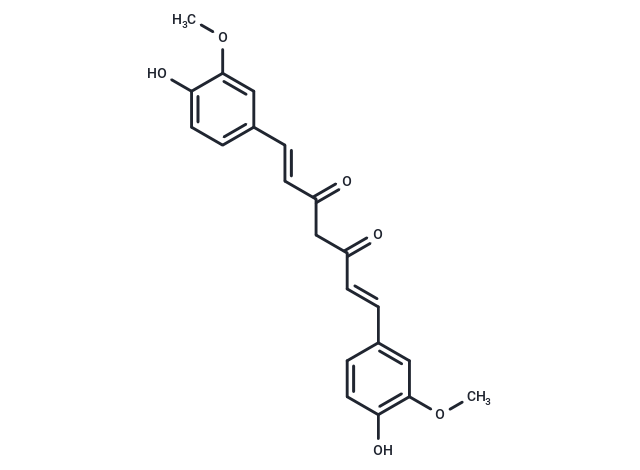Shopping Cart
- Remove All
 Your shopping cart is currently empty
Your shopping cart is currently empty

Curcumin (Natural Yellow 3) is a phenolic natural product, an inhibitor of histone acetyltransferase p300/CREB (IC50=25 μM) with specificity. Curcumin has a wide range of pharmacological activities such as antitumor, anti-inflammatory and antioxidant.

| Pack Size | Price | Availability | Quantity |
|---|---|---|---|
| 25 mg | $30 | In Stock | |
| 50 mg | $38 | In Stock | |
| 100 mg | $50 | In Stock | |
| 200 mg | $57 | In Stock | |
| 500 mg | $88 | In Stock | |
| 1 mL x 10 mM (in DMSO) | $50 | In Stock |
| Description | Curcumin (Natural Yellow 3) is a phenolic natural product, an inhibitor of histone acetyltransferase p300/CREB (IC50=25 μM) with specificity. Curcumin has a wide range of pharmacological activities such as antitumor, anti-inflammatory and antioxidant. |
| Targets&IC50 | p300 HAT:25 μM |
| In vitro | METHODS: Retinoblastoma cells SO-Rb50 and Y79 were treated with Curcumin (10-50 μM) for 24 h. Cell viability was measured by CCK-8. RESULTS: Curcumin dose-dependently and significantly decreased the cell viability of SO-Rb50 and Y79 cells, with IC50s of 38.4 μM and 34.8 μM, respectively.[1] METHODS: Mouse colon cancer cells MC38 were treated with Curcumin (5-50 μM) for 48 h. Apoptosis was detected by Flow Cytometry. RESULTS: Curcumin dose-dependently induced apoptosis in MC38 cells. [2] METHODS: Human pancreatic cancer cells PANC1 were treated with Curcumin (10-80 μg/mL) for 24 h. The autophagy marker LC3 was detected by Immunofluorescence. RESULTS: The highest expression level of punctate autophagosomes was found in 40 μg/mL Curcumin-treated cells. [3] |
| In vivo | METHODS: To detect the anti-tumor activity in vivo, Curcumin (100-200 mg/kg) was administered by gavage every three days for three weeks to C57BL/6J mice bearing mouse colon cancer tumor MC38. RESULTS: The average tumor volume and tumor weight of mice in the Curcumin treatment group were significantly reduced, and the tumor volume and tumor weight of the 200 mg/kg treatment group were also significantly lower than those of the 100 mg/kg treatment group. [2] METHODS: To detect anti-tumor activity in vivo, Curcumin (25-50 mg/kg) was injected intraperitoneally into BALB/c mice bearing Ehrlich ascites tumor EAT once daily for ten days. RESULTS: The number of EAT cells in the peripheral tissues of the Curcumin 50 mg/kg group was significantly less than that of the tumor control group. [4] |
| Cell Research | 1×104 B16-R cells are cultivated as monolayer culture for 12 hr. They were then incubated in 200 μL of RPMI, 10% FBS containing curcumin at final concentrations from 1–100 μM in 96-multiwell plates for 24-48 hr. After these incubations, cells are washed twice in PBS and 500 μl of fresh culture medium containing MTT (0.3 mg/mL) are added for colorimetric assay. (Only for Reference) |
| Alias | Turmeric yellow, Natural Yellow 3, Indian Saffron, Diferuloylmethane |
| Molecular Weight | 368.3799 |
| Formula | C21H20O6 |
| Cas No. | 458-37-7 |
| Smiles | COC1=CC(\C=C\C(=O)CC(=O)\C=C\C2=CC(OC)=C(O)C=C2)=CC=C1O |
| Relative Density. | 0.93 |
| Storage | Powder: -20°C for 3 years | In solvent: -80°C for 1 year | Shipping with blue ice. | ||||||||||||||||||||
| Solubility Information | DMSO: 60 mg/mL (162.88 mM), Sonication is recommended. Ethanol: 1.8 mg/mL (4.89 mM), Sonication is recommended. 10% DMSO+40% PEG300+5% Tween 80+45% Saline: 6 mg/mL (16.29 mM), In vivo: Please add the solvents sequentially, clarifying the solution as much as possible before adding the next one. Dissolve by heating and/or sonication if necessary. Working solution is recommended to be prepared and used immediately. | ||||||||||||||||||||
Solution Preparation Table | |||||||||||||||||||||
DMSO
| |||||||||||||||||||||

Copyright © 2015-2025 TargetMol Chemicals Inc. All Rights Reserved.